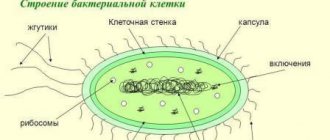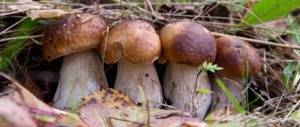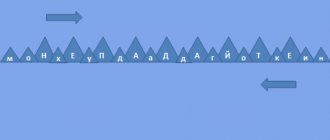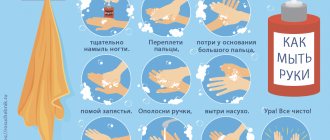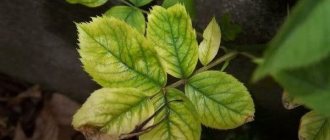Slide captions:
1. Choose the correct statements. 1. White planaria is a free-living animal. 2. Planaria have digestive, respiratory, excretory and nervous organ systems. 3. Undigested food remains in planaria are thrown out through the mouth. 4. The nervous system of planaria is of the nodal type. 5. Planaria are dioecious animals. 6. Flatworms do not have a body cavity. 7. Planaria have well-pronounced regeneration. 8. Fertilization in planaria is external.
2. Choose the correct answer. 1. The adult liver fluke parasitizes the body of: a) small pond snail b) small and large livestock c) predatory fish d) wolves and dogs 2. Intermediate hosts are organisms in which live: a) adult parasites b) adult parasites reproduce c) eggs are preserved d) larvae develop
3. The main hosts are organisms in which they live: a) adult parasites live b) larvae develop c) larvae feed d) only females live 4. Intermediate host of the liver fluke: a) cattle b) small pond snail c) wolf or dog ; d) sheep and goats.
5. Bovine tapeworm larvae live: a) in fresh water bodies b) in the body of pigs and sheep c) in the intestines and muscles of cattle d) in the intestines of dogs and cats. 6. Parasitic flatworms lay eggs: a) many times more than free-living ones b) as many as free-living ones c) much less than free-living ones
Topic: Roundworms and progress.
External structure Body dimensions: from 0.05 mm to several meters. The body is fusiform, unsegmented, tapering towards the anterior and posterior ends, round in diameter.
roundworm flatworm
Skin-muscle bag Under the cuticle there is 1 layer of longitudinal muscles. Movement due to lateral bending of the body. A primary body cavity filled with fluid. Function of fluid: support, transport of substances.
General characteristics 1. They have bilateral symmetry 2. Three-layer 3. The body is long and elastic. 4. In cross section the body is round 5. When moving they can only bend 6. The body is covered with a skin-muscular sac 7. Inside there is a body cavity filled with liquid 8. An anus appears 9. dioecious
Nervous system and sensory organs Peripharyngeal nerve ring and six nerve trunks connected by numerous jumpers. Sense organs: touch (tubercles or bristles), chemical sense, vision (primitive eyes - pigment spots).
Digestive system Mouth – pharynx – intestine (straight tube) – anus.
Excretory system Unicellular skin glands
Reproductive system Dioecious. Sexual dimorphism - males and females have clear external differences. They lay eggs and there are viviparous forms.
Worms are human parasites. Human roundworm. The length of females is 20-40 cm, males are 15-25 cm. A parasite of the human small intestine. The final and intermediate host is humans. Disease: ascariasis
The development cycle of roundworm.
Pinworm The length of females is up to 12 mm, males - up to 5 mm. Lives in the large intestine of humans and some monkeys. Disease: enterobiasis.
Trichinella Length of males is 1.6 mm, females - 4.4 mm. Lives in the small intestine of humans. The intermediate host is a pig. Larvae in calcareous capsules settle in the muscles. Disease: trichinosis
Rishta Rishta, or medical string. Length 120cm, thickness – 1-1.7mm. It lives in lymphatic vessels, lymph glands and subcutaneous tissue, mainly in human legs. The intermediate host is Cyclops. Disease: dracunculiasis.
Filament (fillaria) Length 9cm. Lives in the lymph glands and lymphatic vessels of humans, causing their blockage and inflammatory thickening of tissues. The intermediate host is a mosquito. Disease: elephantiasis.
All roundworms are parasites. The outside of nematodes is covered with a cuticle. Parasitic nematodes do not have a digestive system. Inside the skin-muscle sac, nematodes have a large body cavity. All nematodes have a circulatory system.
The roundworm has special attachment organs. The sense organs of roundworms are poorly developed. All nematodes have a digestive system. The human roundworm parasitizes the human intestine. Nematodes are plant parasites.
Download material
so UNT / Lesson developments / Biology lessons
lesson summary General characteristics of roundworms.
10/27/2015 2599 522 Voronina Irina Viktorovna
Zoological thriller
Target:
updating the sanitary and hygienic aspect through the formation of a knowledge base on the topic “type of roundworms”.
DURING THE CLASSES
1.Organizational moment –
assessing the readiness of the class and students for the lesson, greeting students and guests.
2. Introductory and motivational stage Updating knowledge:
In 1995, the journal Nature Australia published an interesting note. An Australian who looked into the kitchen in the morning found a large dead spider on the table. What made him come to die in such an inappropriate place? But the owner of the house experienced even greater surprise and disgust when he looked into a nearby cup with the remains of yesterday’s coffee - a large worm that had come from nowhere was floating there... Mr. Gray, the man with whom this story happened, is a biologist, and he managed to solve the riddle.
The topic of the lesson is the zoological thriller “Roundworms”. Goal: write a script for a zoological thriller to study material on this topic.
Script writing.
Preparatory stage.
1. “Storyboard” – test of knowledge on the topic “Type of Flatworms”.
First frame
Exercise
: Diagrams of which planarian organ systems are presented here? Sign it.
Digestive excretory nervous reproductive system
……………………… …………………… ………………….. ……………..
Figure 2.
Third frame
Exercise
: Describe the developmental cycle of the liver fluke.
With the cattle's feces, the egg enters the water, develops into a free-living floating larva, it penetrates the body of the snail (intermediate host), a new generation of larvae emerges, which become attached to the grass in the form of cysts. When cattle eat grass, they swallow a cyst, which bursts in the gastrointestinal tract, the larva penetrates the blood and reaches the liver, where it develops into a sexually mature individual - a hermaphrodite.
Students are encouraged to independently study the material in textbooks and additional literature and write down the main things that they think are interesting. After writing each scene, a short discussion is organized.
2. “Definition of the cast” - classification of roundworms.
Kingdom – Animals
Subkingdom –
Multicellular
Type –
Roundworms
Representatives:
threadworm, nematodes, guinea worm, trichinella, roundworm, pinworm, hairworm, kinorhynchus, rotifer, etc.
3. “Script writing” – learning new material
Scene 1
Distinctive features of roundworms:
1. About 15 thousand species 2. Body unsegmented, cylindrical, fusiform 3. Round in cross section 4. Primary body cavity 5. Presence of an anus 6. Only 1 layer of longitudinal muscles, only bends 7. Most are internal parasites of plants, animals and humans .
Scene 2
External structure of roundworms.
Figure 4.
Body shape – spindle-shaped
Integument -
cuticle
Body length -
females 20-40 cm, males 15-25 cm in length
Outgrowths on the body -
absent
Organs at the anterior end -
a mouth with three lips
Organs at the posterior end -
anus.
Scene 3
Internal structure of roundworms.
Figure 5.
Scene 4
Life processes of roundworms.
1. Movement – one layer of longitudinal muscle fibers, only bending.
2. Nutrition -
food passes through the mouth and pharynx into the tube-shaped intestine, undigested remains are removed through the anus.
3. Breathing -
breathe with the entire surface of the body.
4. Blood circulation
is absent; metabolic functions are performed by the primary cavity.
5. Excretion -
the system is represented by a pair of lateral canals, merging under the pharynx into one, opening on the abdominal side.
6. Sensitivity –
the nervous system is of the ladder type, the sense organs are poorly developed.
7. Reproduction –
dioecious animals, they reproduce only sexually, fertilization is internal.
Scene 5
The development cycle of roundworm.
Scene 6
Measures to prevent diseases caused by helminths.
1. Wash your hands before eating.
2.
Wash vegetables and fruits well.
3.
Follow the technology for preparing meat and fish.
4.
Do not use untreated water.
5.
Do not swim on wild beaches.
The final scene.
Roundworms are ubiquitous and have a high number of individuals, which indicates the biological progress of this type of worm, despite the simplicity of their organization due to the parasitic lifestyle.
The denouement of the zoological thriller is read out.
The worm in the coffee cup turned out to be a representative of the mermitid family, which belongs to one of the classes of roundworms - nematodes. Mermitids are distributed throughout the world. Adult worms live freely in water or soil, but their larvae are parasites of arthropods. They do not leave spiders, crustaceans, or insects in their “attention.” Once inside the host's body, the larva literally eats it out from the inside. When the time comes for the larva to come out, its owner heads towards the water, even if he is a land dweller. The spider, along with its terrible cargo, obeying an unknown order, went in search of the nearest body of water, and it turned out to be a cup of coffee. Here the mature parasite tore its covers and came out. The owner of Mermitida is no longer needed - he is “allowed” to crawl onto land. Apparently, this is what happened in Mr. Gray's kitchen.
4. Homework –
paragraph, , fill out the table (
Appendix 2
)
5. Lesson summary.
Reflection and self-analysis of the lesson.
See the downloadable file for the full text of the material.
The page contains only a fragment of the material.
On the topic: methodological developments, presentations and notes
Presentation for the lesson “Type of Flatworms”.
- consider the features of the organization of roundworms, the diversity of their species; - identify the features of the high organization of roundworms compared to flatworms.
Integrated lesson-game in biology and ecology on the topic: “General characteristics of flat and roundworms.
Features of parasitic worms• They have organs of attachment• They have protective covers• Many organs are underdeveloped• They have high fertility.
Lesson No. 7. Topic: Type Flatworms: diversity, lifestyle and behavior. Significance in nature and human life. Purpose: to introduce students to the general characteristics of the type of flatworms, the features of their art.
This electronic educational resource is used when studying the topic “Type Annelids. Class Oligochaetes” in the 7th grade, Pasechnik’s educational complex.
The presentation discusses the external structure of an earthworm and presents an algorithm for performing laboratory work No. 2 “External structure of an earthworm; movement; irritability".
- Download presentation (1.99 MB) 681 downloads 4.3 rating
- 1
- 2
- 3
- 4
- 5
Abstract for the presentation
Presentation work on biology on the topic: “Type Roundworms,” created by the teacher specifically to introduce students to representatives of these animals, the features of their structure and reproduction.
- Nematodes
- Type roundworms
- Classes
- general characteristics
- Comparative characteristics of flat and roundworms
- Aromorphoses
- Konstantin Ivanovich Scriabin
- Roundworm development cycle
- Ways of infection with ascariasis
To conduct a lesson by a teacher
Type Roundworms
Roundworms inhabit a wide variety of living environments
: sea and fresh water bodies, soil, human organisms, animals and plants.
Lifestyle
:
free-living and parasites
.
Body measurements
vary from a few millimeters (soil worms) to several meters (sperm whale parasite).
Roundworms are multicellular, three-layered animals with bilateral symmetry.
The body
is not divided into segments
.
It is thin, long, and has a cylindrical shape
.
In cross section, the body has the shape of a circle. This is where the name of the type comes from. In roundworms, a body cavity appears for the first time
, i.e. the space between the skin-muscle sac and internal organs. Let us remember that in flatworms this space was filled with parenchyma.
Like flatworms, roundworms lack respiratory and circulatory systems.
Gas exchange occurs throughout the body.
But there are digestive, excretory, nervous and reproductive systems
.
Type Roundworms have a huge number of species. But the most numerous class in the type of roundworms are Nematodes
(translated from Greek means “thread”). Nematodes have colonized a wide variety of habitats.
Let's consider the structure of Nematodes using the example of the human roundworm
.
It parasitizes the human small intestine
.
Ascaris is quite large in size. The body is thin, long, cylindrical, pointed at the ends
.
The worm is yellowish in color. Female and male roundworms have external differences. The female measures 25–40 cm and is larger than the male
, measuring about
15 cm
.
The posterior end of the male's body is spirally twisted
.
The phenomenon when males and females are externally distinguishable in biology is called sexual dimorphism
.
The body wall is formed by a skin-muscular sac
consisting of cuticle, epithelium and muscles.
The body is covered with a dense shell - cuticle
.
It protects the roundworm from digestion in the host's intestines. Under the cuticle there is an epithelium, and under it there is 1 layer of muscle
.
Due to the presence of one layer of muscles, the worm cannot make complex movements, but only bends like a snake.
The body cavity
is filled with fluid
that is under pressure. Cavity fluid gives the body elasticity and ensures the transport of substances between cells and organs.
The digestive system
has a foregut and a midgut
.
In the foregut there is a mouth
surrounded by
three lips
and used to capture food.
Behind the mouth comes the pharynx
, and behind it
the esophagus
.
The midgut is not divided into parts
and it is where digestion and absorption of nutrients occurs.
For the first time , the hindgut and anus appear
, which were absent in flatworms. In flatworms, undigested food remains were excreted through the mouth. Due to the appearance of the anus, food masses pass in one direction and are released through the anus.
Excretory system.
Waste products accumulate in the cavity fluid, then enter the
lateral excretory canals
, which run along the entire body and merge under the pharynx into one
common canal
, which opens on the abdominal side of the body
with an excretory opening
.
The nervous system
consists of the peripharyngeal ring and the nerve trunks extending from it.
The largest nerve trunks are located on the ventral and dorsal sides of the body and are connected to each other by jumpers in the form of half rings.
Because Since roundworm is a parasite, its nervous system is structured quite simply
.
Sense organs are poorly developed. They have taste organs located in special pits in the front of the body. Organs of touch - sensitive bristles
- located throughout the body.
Reproductive system.
Ascaris, like most representatives of roundworms,
is a dioecious worm that reproduces sexually
.
Characterized by high fertility
. A female can lay about 200,000 eggs per day!
The female reproductive system is represented by the ovaries
, in which eggs are formed, the male -
testes
, in which sperm are formed.
Consider the life cycle of the human roundworm
.
Eggs
, deposited by the female, enter the environment.
In order for the eggs to develop further, the following conditions
:
· presence of oxygen;
· high environmental humidity;
· fairly high temperature (about 25 °C).
Egg development takes about two weeks
and as a result,
a larva
.
Now such an egg with a larva is capable of infection
.
The eggs are microscopic in size and have a sticky shell. They can stick to vegetables and fruits and to your hands. If hygiene rules are not followed
(eating unwashed fruits and vegetables, drinking contaminated water and unwashed hands), they enter the human body.
Flies
play a major role in roundworm infection . They carry eggs on their paws, and, crawling over food and dishes, leave them on them.
From the oral cavity
the eggs enter the
intestine
the larvae
emerge .
They penetrate through the intestinal walls into the blood
.
They are carried throughout the body by blood. For their further development, the larvae need oxygen
.
Therefore, with the blood flow they enter the lungs
, then penetrate the
bronchi, trachea, and rise into the pharynx
.
In this case, the larvae cause inflammation, which is accompanied by a cough in humans. With sputum, the larvae enter the oral cavity, are swallowed a second time
and again enter
human
intestine Only after traveling such a long and difficult path do the larvae turn into young roundworms
.
And here, in the intestines, young roundworms turn into adults
, grow, feed and reproduce.
The life cycle of roundworm occurs without changing hosts
.
Roundworms live in the intestines for about a year
, while having
a negative impact on humans:
they poison the body with toxic products of their vital activity, their faces damage the lungs, causing coughing and even bronchitis.
If roundworms live in the intestines in large quantities, they can weave into clumps that cause intestinal obstruction. The lumps can travel up the respiratory tract, sometimes leading to suffocation and death.
Among nematodes, in addition to roundworms, there are many species that are parasites of humans.
Children's pinworm
.
Pinworms are small whitish worms up to 1 cm
that parasitize
the human intestines
,
most often in children
. Females exit through the anus and lay eggs on the skin. The eggs stick to the skin using a special sticky liquid that causes severe itching; children scratch the skin, and pinworm eggs get on their hands. And from dirty hands to mouth. The eggs return to the intestines, where a new generation of parasites is formed. The pinworm lives for about a month.
Whipworm
- a larger parasite, its length reaches
5 cm
. The front part of the body is thin, and the back is thick. The thin anterior part of the body is attached to the intestinal lining. The whipworm feeds on blood cells and intestinal epithelium. Infection occurs by ingestion of eggs by larvae along with water or food.
Worms that lead a parasitic lifestyle are called worms, or helminths.
. Scientists know more than 10,000 parasitic worms.
Konstantin Ivanovich Scriabin
a great contribution to the development of measures to combat helminths . They are as follows:
Wash vegetables and fruits thoroughly before eating;
· drink clean, boiled water;
Wash your hands before eating;
· protect food from flies;
· identify and treat patients;
· consume only well-fried and cooked meat and fish.
Nematodes that parasitize plants are found in nature.
.
These nematodes are called phytopathogenic
(from phytos - plant, pathogenos - causing disease).
The greatest damage to agricultural plants is caused by strawberry, onion, and potato nematodes
.
They are microscopic in size; in their oral cavity they have a piercing organ - stylet
, with which they pierce plant tissue and feed by sucking out their juices.
Roundworms first appear:
body cavity filled with fluid;
· dioeciousness;
· sexual dimorphism;
· hind intestine with anus.



